
Tere Te Vaka is a string figure I learned on Easter Island in
June 1991 from a young girl named Angie. String figures in general are
called Kai Kai in the language of Rapa Nui. Playing with the string,
making figures, string games, all called Kai Kai. This figure develops
into several others, one from another as the maker sings a story. The
story concerns how the first peoples to come to Rapa Nui built ships to
travel over the ocean and bring them to a new home.
1. Opening A, except use middle finger to pick up palm string.
If you want to learn how to do Opening A see the bibliography at the
end of this section.
2. Place the index finger, from below, into the thumb loop and transfer the thumb loop to the index.
3. With the thumb, pick up from below, the far little string and return.
4. With the thumb, go over both index strings and the near middle and
pick up from below, on the back of the thumb, the far middle string.
Return thumb. There are now two loops on the thumb.
5. Drop the loops from the little fingers.
6. With the little, go over middle string and both index strings and
pick up, from below, on back or little, the lower far thumb string.
Return little.
7. Drop both thumb loops.
8. With thumb, go over both index strings, both middle strings, and
pick up from below, on back of thumb, the near little string and return.
9. Insert thumb, from below, into the index loop and navaho.
10. There is now: a thumb loop, index loop, middle loop, little loop; a
triangle at the thumb wherein the near triangle string crosses the palm
and the far triangle string goes to the other hand.
11. Place the middle finger, from above, into the triangle at the thumb
(see 10.) and catch the far triangle string. This far triangle string
hooks over the far thumb string between the thumb and index.
12. Carry this far triangle string, within the crook of the index
finger, over the pair of strings far index and near middle, and place
the middle finger, from above and still carrying the far triangle
string, behind the palm string with the tip of the finger against the
base of the middle finger.
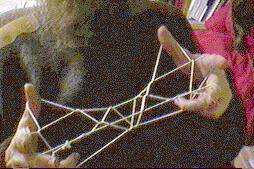
13. Drop the little loops and rotate the hands away extending the
fingers and keeping the middle loop near the top of the middle finger.
This forms the first figure, a foundation of the boat.
All the while string is being manipulated thus far the story teller is singing about the construction of the ship, its many compartments for people and animals and food, details of the materials.
14. Rotate the hands inward and with the ring finger catch the double
string that goes between the hands. Pull this double string down to
form the second figure, the boat.
15. Release the double string. Returns to the first figure.
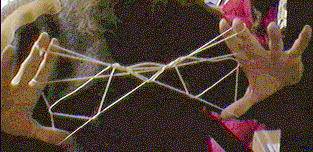
16. See the string that hooks around the middle loop near the middle
finger... Place your hands in your lap whilst keeping the figure
extended but not taut and transfer the middle finger from the present
middle loop to this other string. Watch where the old middle loop goes
when you pick up the new middle loop and extend the third figure. This
is the ship with its masts up being readied to roll into the surf and
set sail.
17. The old middle loop is now a string hooked over the far thumb to near middle string and going toward the knot in the middle of the figure. Release some of the tension on the figure and drop the new middle loop; then with the middle finger, go over the far index string and pick up, from below, on the back of the middle finger, this old middle loop and extend the fourth figure. But take care to not wiggle around at this point.
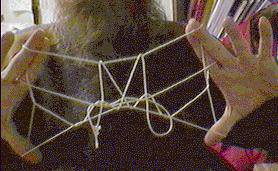
The two tall triangles making an M in the middle are the sails above the ship and the loops to either side of the central figure are the waves.
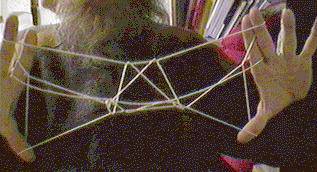
18. Now, with this fourth figure extended, a bit of a wiggle especially with the index finger, whilst increasing the tension on the figure, will snap the two loops at the base of the M in the fourth figure around and
change the shape of the M into a fifth figure, often not symmetrical. At this point in the story the ship has landed at dawn on Rapa Nui and is taken apart to provide material to build shelters.
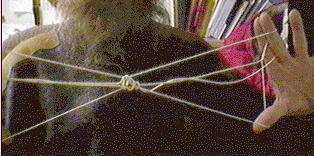
19. Now if you move your hands apart slowly the figure of the shelter in the middle will collapse into the sunset which ends the story.
Bibliography
These first three titles are good books for beginners of Kai Kai. The
fourth title is fairly technical by comparison and includes an
ethnological introduction and comparisons of methods.
Cat's Cradle, Owl's Eyes: A Book of String Games Camilla
Gryski, Beech Tree, ISBN 0-688-03941-3
Many Stars & More String Games Camilla Gryski, William Morrow and Company, ISBN 0-688-05792-6
Super String Games Camilla Gryski, William Morrow and Company, ISBN 0-688-07684-X
String Figures and How to Make Them Caroline Furness Jayne, Dover Books, ISBN 0-486-20152-X
International String Figure Association
Foto Credit: Jeffri Frontz, Ross Island
Last Update: 29sep2009
A.J.Oxton, OA, OO, OAE, k1oIq

Back to ajo
Copyright © 2009, A.J.Oxton, The Cat Drag'd Inn ,
03813-0144.![]()